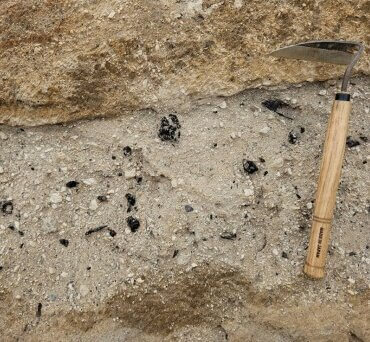
A photo of the Taupō eruption deposit in the field.
I love that volcanoes never cease to amaze me.
I spent a few days last week just southeast of Ruapehu assisting two PhD students with their fieldwork. One is working to understand a set of old ash layers from Ruapehu, the other on old lahar deposits. I say this as someone who studies relatively fresh deposits, preferably still hot. These are recent compared to deposits on the order of hundreds of thousands of years. It’s all relative.

Janine Krippner looking at lahar deposits down the Whangaehu River. Photo: Brian Perttu.
We were looking for a deposit from ‘the Taupō eruption’ about 1,800 years ago (about 232 CE), approximately 70-80 km away from the caldera that produced it. In volcanology, plus fields like archaeology, marker layers/beds/horizons are deposits that have a known age and stretch over broad areas. Simply put, we use them to say the stuff above it is younger, and the stuff below it is older. This gives us relative ages. In the lab we can use different techniques to narrow this down even further. For deposits younger than 50,000 to 60,000 years we can use Radiocarbon, or Carbon-14 dating if we have carbon (for example, wood) to calculate the age.

Janine Krippner
This particular Taupō eruption deposit is a great marker bed for the region. It is mostly whiteish pumice and ash, and it is very easy to tell apart from the other deposits because of the significant amount of black, charred wood fragments. We call this deposit an ‘ignimbrite’. From the components we can already tell two important things – pumice forms when viscous magma is blown apart violently by rapidly expanding gas bubbles, and the presence of burned wood tells us that it was hot. One study found that the minimum charring temperatures ranged 269 to 398°C, which is actually quite cool for a volcano. That is the minimum though, and it is quite hot for us, Seeing this so far from the vent tells us that it was a very large eruption, and everything between me and the vent would have been devastated. In fact, this was the most powerful eruption in the past 5000 years, globally. Thankfully these eruptions are rare compared to the much, much smaller ones.
The eruption produced a massive pyroclastic flow, made of pumice, ash, and hot gas that raced across the landscape at over 200-300 metres per second, devastating around 20,000square kilometres. My colleague and I discussed what it would have looked like where we stood all those years ago. A huge, expanding, grey cloud rising over the hills, filling up our view. Would we run? Yes of course we would try. Would it help? With something this big, no.
Seeing deposits in the field I understand a little more about them, and I have even more questions. When I get back from the field, I scour the research to see if someone has answered them. It takes many researchers to understand events like this, each building upon the work of the last. Like detectives working to uncover the secrets within the deposits, we piece together the timeline from the magma forming far below the ground, through to how the landscape was altered. We then get to stand in the field with images in our minds of what those eruptions looked like, and marvel at how our landscape was transformed in a geological blink of an eye.

A photo of the Taupō eruption deposit in the field.








